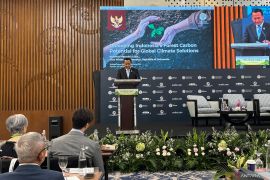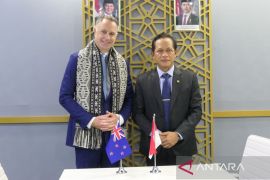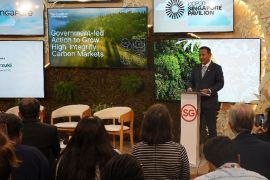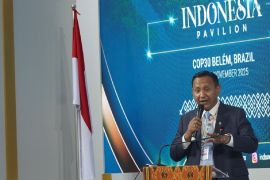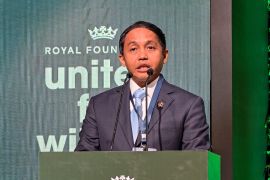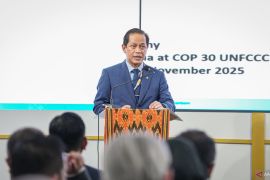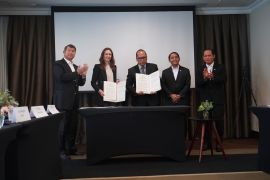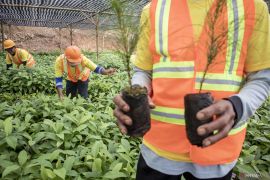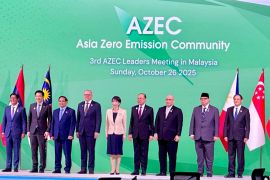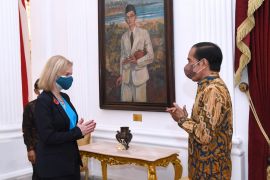He was joined in the National Mangrove Planting activity by Defense Minister Prabowo Subianto; Indonesian Defense Forces Commander Admiral Yudo Margono; Chief of the National Police General Listyo Sigit Prabowo; and other officials.
During the activity, officials and about 1 thousand soldiers stepped into a swampy site, with the water reaching up to their thighs and even their chests to plant mangroves.
"Those who want an interview, come here," President Widodo quipped while waving to journalists taking pictures from the safety of a bamboo pier.
After planting mangroves, he said that the activity was meant to protect Indonesia's coastline from possible climate change impacts that could cause sea levels to rise or big waves to pummel the coast.
"This (planting) is the highlight. We know we have the widest mangroves in the world; 3.3 million hectares of our mangrove forests are the largest in the world. That's what we have to care for, we protect, if there is critical land we replant it, so that there will be no damage to our mangrove forests," said the President.
The area under mangrove forests in Indonesia has reached 3.31 million hectares. These forests can absorb 33 billion tons of carbon dioxide (CO2) or 950 tons of carbon per hectare. Indonesia is also the country with the longest coastline in the world.
Apart from mangroves, Indonesia also has the largest peat forests covering 7.5 million hectares, which can absorb 55 billion tons of carbon emissions, and also tropical rainforests covering an area of 125.9 million hectares that can absorb 25.18 billion tons of carbon emissions.
With these three forest strengths, Indonesia can be protected not only from climate change, but also enjoy great economic potential from carbon trading.
Carbon trading
In simple terms, carbon trading involves the purchase and sale of carbon credits. A carbon credit represents the right of a company to emit carbon emissions or other greenhouse gases (GHG) in its industrial process. One unit of carbon credit is equivalent to reducing 1 ton of carbon dioxide (CO2) emissions.
The government in the area where a company sets up a production facility sets limits on the carbon credits that the company can generate in its territory. If a company produces less emissions than credits, it can sell its credits in the carbon market.
Conversely, if a company's emissions exceed its credit, it pays a fine or buys credit from the carbon market. Carbon credits that are sold generally come from green projects, such as companies that own forest land. A verification agency issues carbon credits in the form of a certificate that determines the amount of carbon credits generated.
Thus, countries can control the amount of carbon emissions produced and reduce the impact of greenhouse gases significantly.
Indonesia is targeting GHG reductions of 29–41 percent by 2030 and has made a commitment to bring down emissions to zero by 2060. In fact, under the enhanced Nationally Determined Contributions (NDC), Indonesia is targeting emission reductions of 31.89–43.2 percent.
Carbon trading also opens up new economic opportunities for participating countries.
Carbon trade regulations
Currently, the government is preparing carbon trade regulations. The legal basis for the regulations already exists, which is Law No. 4 of 2023 on Financial Sector Development and Strengthening (P2SK), which was stipulated on January 12, 2023.
Article 24 of the law states that domestic and/or foreign carbon trading can be carried out using a carbon exchange mechanism. Carbon exchanges can only be held by market operators who have obtained business licenses from the Financial Services Authority (OJK). The exchange carbon center must be domiciled in Indonesia.
Subsequent provisions on carbon trading through carbon exchanges will be regulated via OJK regulations after consultation with the House of Representatives (Article 26).
To discuss the implementation of the law, on May 3, 2023, President Widodo chaired an internal meeting on carbon trading, which was attended by the Coordinating Minister for Economic Affairs, Airlangga Hartarto; Minister of Energy and Mineral Resources (ESDM), Arifin Tasrif; Minister of Environment and Forestry (LHK), Siti Nurbaya Bakar; Minister of Investment, Bahlil Lahadalia; and other officials.
After the meeting, Lahadalia said that the government has agreed that carbon credits in Indonesia will not be sold on a foreign stock exchange.
"We want (credits) to be sold on the Indonesian stock exchange and the price must be better," he informed on May 3.
According to Lahadalia, carbon can still be openly traded in Indonesia, but the trade must be registered, and everything must be conducted through a carbon exchange trading governance mechanism regulated by the OJK.
“Later, all will be registered at the LHK (Ministry of Environment and Forestry), but only once. Before entering the carbon exchange, you must first register at the LHK. After that, you can trade on the carbon exchange, like ordinary stock trading,” he explained.
However, a number of things are still needed to be improved, including the issue of structuring permits for protection forest concessions, conservation forests, and other permits.
"This is what we will conduct a review (of). Currently, the concessions are owned by companies. Later, everything will be controlled and managed by the government so that the carbon that goes abroad can be sold, because if certification is not made, we will not know how much will become a source of income for our country," the minister added.
Meanwhile, Minister Hartarto outlined the sectors that are most connected to carbon trading, such as the energy, forestry, and industrial sectors.
The energy sector has been linked to the energy transition through existing programs resulting from the G-20 Summit—the Just Energy Transition Program (JETP) and the ASEAN Net Zero Emission program. The programs have been rolled out in cooperation with Japan, several G-20 countries, and the G-7.
In the forestry sector, one of the indicators is forest and land use (FOLU), Hartarto added. In addition, the most important thing is certification and traceability.
Meanwhile, in the industrial sector, the clearing function is important, which is done through the warehouse receipt system (SRG) registered with the Ministry of LHK.
"So, if the land used for carbon trading is clear at the start, then it can only be traded," he explained.
Meanwhile, the Minister of ESDM said that the ministry is only a supporter that will show where carbon supplies come from. Tasrif said that the standardization and calculation of carbon values will be carried out at the respective ministries, namely, the Ministry of LHK, Ministry of ESDM, and Ministry of Industry.
On a separate occasion, OJK chief Mahendra Siregar said the carbon exchange is planned to be launched in the second half of 2023.
Carbon trading practices
The practice of carbon trading has already been carried out in Indonesia, but the volume is still small. For example, Central Kalimantan has a project on carbon trading in the form of carbon offsets called Katingan Mentaya, which has been launched and managed by PT Rimba Makmur Utama (RMU).
The Katingan Mentaya project is based on the conservation of 149,800 hectares of peatlands, which store more than 90 percent of carbon. The project simultaneously saves peat forests in the Katingan area from being developed into industrial acacia plantations and has the potential to release 450 million tons of carbon dioxide in the next 60 years.
Katingan Mentaya still follows the Verified Carbon Standard (VCS) as well as Community and Biodiversity Standards (CCB).
For this reason, a basis for setting carbon prices is needed by Indonesia's own verification agency, an analyst from Climate Policy Initiative Indonesia, Alke Rabinsa Haesra, said at an "Indonesian Climate Journalist Network" (ICJN) program in Jakarta.
"What is the baseline price determination? Is one carbon from PLTUs (steam-fired power plants) the same as carbon from transportation or production machinery? The important thing is (for) pricing to be determined because a reasonable price goes up and down is determined from that baseline because what is missing is a fair price that can be accepted by the private sector and community," he added.
He said that the carbon trading mechanism can actually divert fund flows from developed countries, which produce a lot of carbon, to developing countries that need funds for economic growth, but have a lot of green energy potential, like Indonesia.
"Carbon trading in Indonesia is still concerned with trading PLTU carbon; there are no regulations for other sectors. Therefore, the source of the carbon market in Indonesia is still at a very early stage. We are already on the right track, but for the surplus turnover of emissions at the PLTU and those at the company, the effect is still in the developmental stage," Haesra added.
He urged the government to immediately set a target for completing carbon exchange regulations in view of the international pressure on Indonesia to have a stronger carbon exchange.
"Indonesia also has a carbon market and there is a stand-by buyer, but there are no regulations for the carbon market yet. So, the regulations and goods must be held accountable first," Haesra explained.
Executive Director of the Center of Economic and Law Studies (Celios), Bhima Yudhistira, said that the government needs to regulate tariffs and trade permits, including deciding who will be the carbon exchange organizer.
"In Europe, it is clear that carbon exchange organizers may be from commodity exchanges, futures exchanges, or even technology companies. In Sweden, every individual can buy carbon credits with crypto because the market is open. If you meet the permit requirements, you can become an organizer, if you have money, you can join the carbon market," he informed during a public discussion.
He suggested that carbon exchange organizers be kept separate from stock exchange organizers, such as technology companies. The goal is to create innovation and service development, as has been the case in some countries that are deepening carbon exchanges with the help of technology.
Furthermore, the characteristics of a stock exchange and a carbon exchange are different.
"One is the calculation of shares, the other is carbon credit. Shares are proof of ownership of a company, while this one is not proof of ownership, but it turns out that it is from the carbon, not if we buy carbon then forests in Kalimantan are held by the company that bought the carbon credits, but the carbon becomes intangible goods that are different from ownership," Yudhistira expounded.
A member of Commission XI of the House of Representatives (DPR) from the Golkar Party faction, Mukhamad Misbakhun, said he hopes that the government will pay attention to three things in carrying out carbon exchange regulations.
First, regulators must keep their distance from carbon exchange organizers. Second, the organizer of the carbon exchange must be independent because it is believed that it will attract the interest of carbon market players around the world to participate in enlivening carbon trading in Indonesia. Finally, the assessors of greenhouse gas emissions must be credible and provide a reference for carbon prices.
Therefore, there is a need for a holistic road map that keeps innovation open so that the carbon market in Indonesia, in addition to being economically profitable, can really accelerate the achievement of net zero emissions.
Related news: Carbon trading open but firstly register through KLHK: Minister
Related news: Indonesia ready for full carbon trading system by 2025: official
Related news: Carbon tax becomes instrument to achieve NDC target, NZE: Nazara
Translator: Desca Lidya Natalia, Cindy Frishanti Octavia
Editor: Sri Haryati
Copyright © ANTARA 2023

